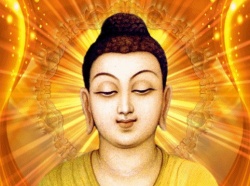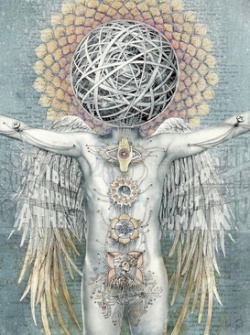Twelve Nidānas
The Twelve Nidānas(Pali/Sanskrit: निदान Nidāna "cause, foundation, source or origin") are an application of the Buddhist concept of Pratītyasamutpāda (Dependent origination). They identify the origin of Dukkha (Suffering) to be in Avijja (ignorance). The twelve links in the chain of existence or causation; they are as follows:
1) Avidya, ignorance or unenlightenment;
2) Samskara, action, activity, conception, "dispositions";
3) Vijnana, consciousness;
4) Namarupa, name and form;
5) Sadayatana, the six sense organs, i.e., eye, ear, nose, tongue, body and mind;
6) Sparsa, contact, touch;
7) Vedana, sensation, feeling;
8) Trsna, thirst, desire, existing;
9) Upadana, laying hold of, grasping;
10) Bhava, being, existing;
11) Jati, birth;
12) Jaramarana, old age and death.
Descriptions of the Twelve Nidanas
Pali literature
Several series of Nidanas are described in the suttas.
Dīgha Nikāya Sutta 1, the Brahmajala Sutta, verse 3.71 describes six Nidanas:
- ...They experience these feelings by repeated contact through the six sense-bases; feeling conditions craving; craving conditions clinging; clinging conditions becoming; becoming conditions birth; birth conditions aging and death, sorrow, lamentation, sadness and distress.
Dīgha Nikāya Nikāya, Sutta 14 describes ten links, and in Sutta 15 nine links are described, but without the six sense-bases.
Commentarial literature
The Twelve Nidānas are explained in detail in the Visuddhimagga of Buddhaghosa, the central text of the Mahāvihāra commentarial tradition. Buddhaghosa recounts four methods to interpret the Twelve Nidanas:
- Working from "bottom to top",
- Working from the "middle to the top",
- Working from "top to bottom",
- Working from the "middle to the source".
The first method begins with ignorance and proceeds to sickness, old age, and death. The second method begins with attachment and proceeds to birth. The third method begins with birth and proceeds back to ignorance. The fourth method begins with attachment and proceeds to ignorance.
The Twelve Nidanas
- See also:Pratītyasamutpāda
The Twelve-fold Chain
Reverting the chain
Understanding the relationships between the phenomena that sustain Dukkha is said to lead to Nibbana, complete freedom from Samsara
Phenomena are sustained only so long as their sustaining factors remain. This causal relationship is expressed in its most general form as follows:
- When this exists, that comes to be. With the arising of this, that arises. When this does not exist, that does not come to be. With the cessation of this, that ceases.
- — Samyutta Nikaya 12.61
This natural law of this/that causality is independent of being discovered, just like the laws of physics. In particular, The Buddha applied this law of causality to determine the cause of Dukkha.
The reversal of this causal chain shows the way to put an end to stress: "From the remainder less fading and cessation of ignorance comes the cessation of (volitional) fabrications" et cetera.
Three lives and Five Skandhas
The Nikayas themselves do not give a systematic explanation of the Nidana series. As an expository device, the commentarial tradition presented the factors as a linear sequence spanning over three lives, thus shifting the theme from a single conception (and birth) to a sequence of "incarnations" (roughly speaking).
According to Schumann the Nidanas are a later synthesis of Buddhist teachings, meant to make them more comprehensible. Comparison with the five skhandhas shows that the chain contains logical inconsistencies, which can be explained when the chain is considered to be a later elaboration. This way it is explainable that nama-rupa en consciousness in the 9-fold are the beginning or start, while in the 12-fold chain they are preceded by ignorance and formations. Those can only exist when nama-rupa en consciousness are present. Schumann also proposes that the 12-fold is extended over three existences, and illustrate the succession of rebirths. while Buddhaghosa en Vasubandhu maintain a 2-8-2 schema, Schumann maintains a 3-6-3 scheme, putting the Five Skandhas aside the Twelve Nidanas.
| Commentarial tradition |
|---|
| Former life |
| Ignorance |
| Formations (conditioned things) |
| Current life |
| Consciousness |
| Mind and body (personality or identity) |
| The six sense bases (five physical senses and the mind) |
| Contact (between objects and the senses) |
| Feeling (registering the contact) |
| Craving (for continued contact) |
| Clinging |
| Becoming (similar to formations) |
| Future life |
| Birth |
| Old age and death |
| Schumann | |
|---|---|
| The 12-fold chain | the 5 skhandhas |
| First existence | |
| 1. Body | |
| 2. Sensation | |
| 3. Perception | |
| 1. Ignorance | |
| 2. Formations | 4. Formations |
| 3. Consciousness | 5. Consciousness |
| Second existence | |
| 4. Nama-rupa | 1. Body |
| 5. The six senses | |
| 6. Touch | |
| 7. Sensation | 2. Sensation |
| 3. Perception | |
| 4. Formations | |
| 5. Consciousness | |
| 8. Craving | |
| 9. Clinging | |
| Third existence | |
| 10. Becoming | |
| 1. Body | |
| 11. Birth | |
| 2. Sensation | |
| 3. Perception | |
| 4. Formations | |
| 5. Consciousness | |
| 12. Old age and death | |
Conception and birth
The Twelve Nidanas may be seen as an explanation of the conception and the development of the embryo:
- The 12-links formula is unambiguously an ancient tract that was originally written on the subject of the conception and development of the embryo, as a sequence of stages prior to birth; in examining the primary source text, this is as blatant today as it was over two thousand years ago, despite some very interesting misinterpretations that have arisen in the centuries in-between.
Destiny after Rebirth
Dependent origination also describes the process by which sentient beings incarnate into any given realm and pursue their various worldly projects and activities with all concomitant Suffering. Among these sufferings are aging and death.
Daily life
Contemporary teachers often teach that it can also be seen as a daily cycle occurring from moment to moment throughout each day. There is scriptural support for this as an explanation in the Abhidharmakosa of Vasubandhu, insofar as Vasubandu states that on occasion "the twelve parts are realized in one and the same moment".
For example, in the case of avidyā, the first condition, it is necessary to refer to the three marks of existence for a full understanding of its relation to Pratityasamutpada. It is also necessary to understand the Three Fires and how they fit into the scheme. The Three Fires sit at the very center of the schemata in the Bhavacakra and drive the whole edifice. In Himalayan iconographic representations of the Bhavacakra such as within Tibetan Buddhism, the Three Fires are known as the Three poisons which are often represented as the Gankyil. The Gankyil is also often represented as the hub of the Dharmacakra.
Nirvana is often conceived of as stopping this cycle. By removing the causes for craving, craving ceases. So, with the ceasing of birth, death ceases. With the ceasing of becoming, birth ceases, and so on, until with the ceasing of ignorance no Karma is produced, and the whole process of death and Rebirth ceases.
Understanding in Tibetan tradition
Avidyā
Avidyā (Sanskrit) or Avijjā (Pāli); Tibetan (Wylie transliteration) ma.rig.pa (marikpa), Eng. "ignorance". Ignorance of the Four Noble Truths, the Three marks of existence, the Five Skandhas, Karma, and Pratītyasamutpāda results in a wrong assessment of reality. This narrowness of experience is the primary cause of duḥkha (Suffering dissatisfaction, pain, unease, etc.)
Avidyā may be understood as
- A continuous gradient characterizing not so much a particular state of being, but the quality or direction of situational patterning, experienced as a 'falling away from' the modality of pristine awareness.
Saṃskāra
Saṃskāra (Sanskrit) or Saṅkhāra (Pāli); Tibetan du.byed (duche), Eng. "(mental) formations" The impulse accumulations of Saṃskāra are characterized by the energetic direction of the first motif, manifesting through body, speech, and mind as structuring forces of our being. This relationship forms the basis of our character and our personal karmic patterning.
Vijñāna
Vijñāna (Sanskrit) or Viññāna (Pāli); Tibetan rnam.par.shes.pa or rnam.shes (namshe), Eng. "consciousness" Vijñāna represents the partially structured consciousness that results from the action of Saṃskāra and the shaping of that energetic activity into a less flexible and more stagnant form.
- It is pictured as having a two-fold function: the cognition of objects that arise in our field of awareness and a structured stream that is being continually fed from the reservoir of energetic activity. The interplay between Saṃskāra and Vijñāna is seen as accounting for all the experiential data associated with the psychological notion of the unconscious, including memory, dreams, and the eruption of emotive complexes.
Nama-rupa
Nāmarūpa (Sanskrit and Pāli); Tibetan ming.gzugs (mingzuk), Eng. "name and form" Vijñāna has a quick grasping tendency, moving from sensory objects to objects of imagination rapidly. This energy may therefore crystallize and take shape into mental functions, called Nāma, or it may be represented as material forms, called Rūpa.
As a collective idea, the Nāmarūpa motif models the reciprocal relationship of bodily and mental functioning. Nāma is the naming activity of the discursive mind. Rūpa develops an internal representation of external objects, without which mind and body cannot exist.
- Nāma refers to three components of mental functioning. There is the sensation or tone-awareness of a mental situation. There is also an ideational or labeling function. And finally there is the component of dispositional orientation, the 'mood-energy' we bring to a situation.
- Rūpa refers to the four dynamic structuring operations of solidity, cohesion, heat, and motility. They are represented by the elemental symbols of earth, water, fire, and air. The operation of these elemental modes goes to make up what we experience as our physical world, including our body. Rūpa embraces the static aspects of embodiment such as cellular, tissue, and organ structures, as well as the dynamic aspect of body metabolism--electro-physiological pathways, membrane transport, etc.
Six sense bases
Ṣaḍāyatana (Sanskrit) or Saḷāyatana (Pāli); Tibetan skye.mched (kyemche), Eng. "six sense gates" or "six sense bases" The close relationship of bodily and mental functioning is differentiated into the six-fold bases of awareness, which contribute to the arising of all sensory experiences that make up our interpretation of reality. The six-fold bases are divided into an internal grouping (ādhyātmika) with corollary external (bāhya) supports.
- The internal grouping refers to the integration of five sensory capabilities (eye, ear, nose, tongue, body) and a sixth capability, termed non-sensuous or mental, which refers to the capability of all acts of memory, imagination, visualization, etc. These internal bases are not to be confused with the corresponding physical organs ... They are simply loci of sensitivity structured such that there arises the experience of seeing, hearing, etc.
" The six external bases, which always work in conjunction with the corresponding internal base, refer to the six types of possible object awareness. These bases are the means by which the differentiated aspects, which are fleeting stabilizations in the field character of our awareness, stand out long enough to be appropriated as this-or-that specific object. The external and internal bases should be pictured as working together in pairs. In any given moment there is the two-fold working of a particular modality of awareness (eye-sensitivity and color-forms, ear-sensitivity and sounds, etc.).
Contact
Sparśa (Sanskrit) or Phassa (Pāli); Tibetan reg.pa (rekpa), Eng. "contact" The Sparśa motif refers to the relationship or rapport between the internal and external āyatana. Impressions of tone arise in conjunction with the specific modality of awareness that is operating.
Sensation
Vedanā (Sanskrit and Pāli); Tibetan tshor.ba (tsorwa), Eng. "sensation" There are six types of feeling tone awareness that arise from contact of the āyatana. The feeling tone or sensation of each of the six āyatana is uniquely different. For example, the feeling tone and felt experience of sensations in the body are distinct from the feeling tones generated from experiencing sight or sound.
- Each modality is experientially separable on the basis of (a) the place of sensitivity (internal base), (b) the corresponding structure of its field (external base), (c) the manner of articulation or relatedness between (a) and (b), termed rapport, and (d) the resulting distinctive tone.
Craving
Tṛṣṇā (Sanskrit) or Taṇhā (Pāli); Tibetan sred.pa (sepa), Eng. "craving" or "desire" or "thirst": Following the arising of tone-awareness is an unconditioned or habitually patterned experience of craving or attachment. The type of craving or attachment that follows depends upon which of the six āyatanas is involved, and which of the following three "motivations" is present.
- The motivation of sensual gratification (kāma-tṛṣṇā) is perhaps the most common. It results in simple attachment to whatever arises in one's field of awareness. It is not an overt appropriation, one that we consciously activate. It refers rather to the habitual structuring of experience such that one is compulsively caught up in one situation after another through a process of identification and clinging.
- One can also be motivated with regard to the desire for 'eternals' (Bhava-tṛṣṇā). It is the habitual structuring of any sensory impression, any momentary awareness, such that it might be the occasion for securing an eternal realm of peace and contentment.
- Finally there is the annihilatory motivation (vibhava-tṛṣṇā). It is the automatic structuring of experience such that any sensory activation might be the cause of a compulsive thirst to annihilate and destroy. What is commonly regarded as psychopathic behavior might be linked particularly with this type of motivation.
Attachment
Upādāna (Sanskrit and Pāli); Tibetan len.pa (lenpa), Eng. "attachment" If the object of one's desires comes to fruition, then these craving desires of tṛṣṇā may solidify and manifest as the quality of attachment, or Upādāna. This condition of fulfilled desires and attachment is always fleeting and momentary, as new cravings arise once old cravings are satisfied.
Attachment may take many forms, for example, emotional attachment to persons, to life, material comfort, routines, pleasant or unpleasant sensations, beliefs, thoughts, judgements, etc. We may not have attachment to things like wealth or success in society, but we are typically very strongly attached to our feelings and constructed identity of the self.
One may become fixated on a mental "story" or representation of reality, or a mental version of an object or event, preferring and craving for an unrealized internal version of external reality. Once this fixation shapes behavior in a way that internal desires are satiated, then the craving of tṛṣṇā may be said to have shifted to the attachment of Upādāna.
Becoming
Bhava (Sanskrit and Pāli), Tibetan srid.pa (sipa), Eng. "becoming" "Once the direction of situational patterning has proceeded to the point of overt clinging, a process of becoming, termed Bhava, is initiated. It refers to the new formation of karmic tendencies.
This creation of new habits and karmic [[]]tendencies, called Bhava, will come to fruition through future experiences. Bhava, therefore, differs from Saṃskāra in temporal nature. "Saṃskāra refers to tendencies from past situational patternings (lives) which act on the present situation.
Birth
Jāti (Sanskrit and Pāli); Tibetan skyed.ba (kye wa), Eng. "birth": The Jāti motif refers to the process of karmic tendencies of Bhava coming to fruition, through the birth of new patternings. That which was desired and conditioned now comes to be.
- In a psycho-biological model, Jāti refers to the birth or emergence of a newborn being, appearing, according to the specific history of patterning, in one of six 'lifestyles'. These lifestyles indicate the general character of experience. They are symbolized by the terms gods, titans, hungry ghosts, animals, denizens of hell, and human. These embrace all the general ways of being-in-a-situation.
Aging, decay and death
Jarā-Maraṇa (Sanskrit and Pāli); Tibetan rga.shi (gashi), Eng. "aging (old age), decay and death"
- Once a new situation or a new being has emerged, it is inevitable that the conditions which brought about its appearance will change. This, the last of the twelve motifs, points to the inevitability of decay and death. Decay affects all structures, which are but fleeting stabilizations fed by the energy flow of habitual patterning. When the cessation of the continuity of experience occurs, we speak of death. It is the total breakdown and dissolution of experience and experiencer.
- The process of disintegration, destructuring, and entropic scattering yields a nexus of vibratory murkiness which is the condition of avidyā, the first motif. Thus the entire structure of patterning feeds back on itself, and is often pictured as a circle of twelve sections, called the Wheel of Life (bhavacakra, srid-pa'i-'khor-lo).
Within Buddhist literature
Theravāda
Pali Canon
In the Pali Suttapitaka (the most ancient canon of Buddhist writing preserved by Theravāda tradition) the first (partial) exposition of the twelve nidānas appears in the Dīgha Nikāya (Long Discourses), Brahmajāla Sutta, verse 3.71. The reference is partial because it does not cover all twelve links:" In this same Nikāya, Sutta 14 describes ten links instead of twelve, and in Sutta 15 the links are described, but without the six sense-bases (for a total of nine links in that Sutta).
- ...they experience these feelings by repeated contact through the six sense-bases; feeling conditions craving; craving conditions clinging; clinging conditions becoming; becoming conditions birth; birth conditions aging and death, sorrow, lamentation, sadness and distress.
Descriptions of the full sequence of twelve links can be found elsewhere in the Pali canon, for instance in section 12 of the Samyutta Nikaya:
- Now from the remainderless fading and cessation of that very ignorance comes the cessation of fabrications ... From the cessation of birth, then aging and death, sorrow, lamentation, pain, distress, & despair all cease. Such is the cessation of this entire mass of stress and Suffering.
Theravāda commentaries
In the commentarial literature of the Theravada tradition (attributed, at least mystically, to the author Buddhaghosa, and written many centuries subsequent to the Suttapitaka passages described above) the same doctrine is instead interpreted as a sequence of three lives, thus shifting the theme from a single conception (and birth) to a sequence of "incarnations" (roughly speaking).
Mahayana
According to the Mahayana tradition, The Buddha taught on the twelve links in detail in the Rice Seedling Sutra.






